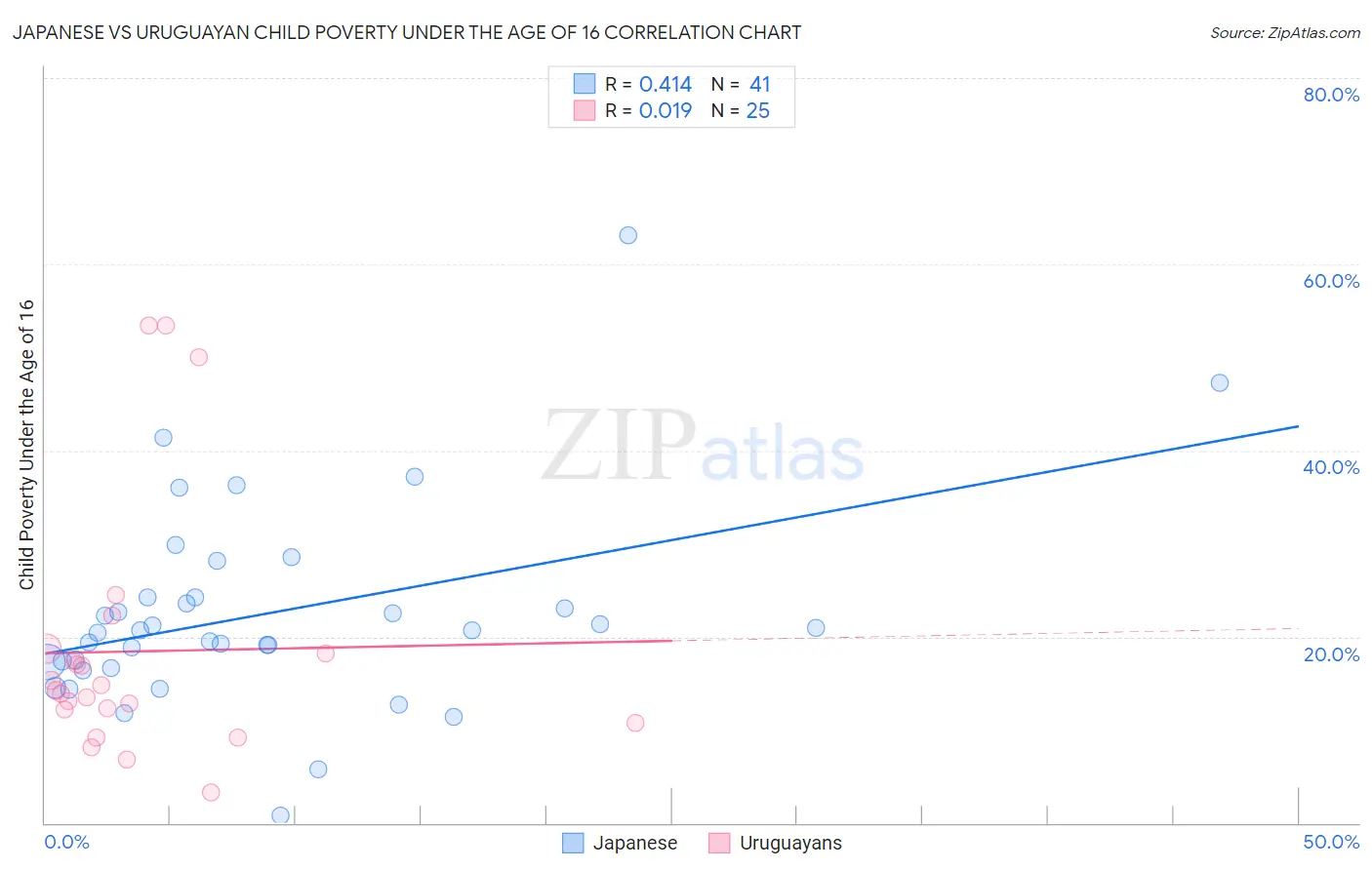Japanese vs Uruguayan Child Poverty Under the Age of 16
COMPARE
Japanese
Uruguayan
Child Poverty Under the Age of 16
Child Poverty Under the Age of 16 Comparison
Japanese
Uruguayans
17.7%
CHILD POVERTY UNDER THE AGE OF 16
4.7/ 100
METRIC RATING
219th/ 347
METRIC RANK
16.1%
CHILD POVERTY UNDER THE AGE OF 16
54.7/ 100
METRIC RATING
169th/ 347
METRIC RANK
Japanese vs Uruguayan Child Poverty Under the Age of 16 Correlation Chart
The statistical analysis conducted on geographies consisting of 248,294,497 people shows a moderate positive correlation between the proportion of Japanese and poverty level among children under the age of 16 in the United States with a correlation coefficient (R) of 0.414 and weighted average of 17.7%. Similarly, the statistical analysis conducted on geographies consisting of 144,396,450 people shows no correlation between the proportion of Uruguayans and poverty level among children under the age of 16 in the United States with a correlation coefficient (R) of 0.019 and weighted average of 16.1%, a difference of 9.7%.

Child Poverty Under the Age of 16 Correlation Summary
| Measurement | Japanese | Uruguayan |
| Minimum | 0.73% | 3.3% |
| Maximum | 63.1% | 53.4% |
| Range | 62.3% | 50.1% |
| Mean | 22.5% | 18.4% |
| Median | 20.6% | 14.2% |
| Interquartile 25% (IQ1) | 16.9% | 11.4% |
| Interquartile 75% (IQ3) | 24.2% | 18.4% |
| Interquartile Range (IQR) | 7.3% | 7.0% |
| Standard Deviation (Sample) | 11.0% | 13.6% |
| Standard Deviation (Population) | 10.9% | 13.3% |
Similar Demographics by Child Poverty Under the Age of 16
Demographics Similar to Japanese by Child Poverty Under the Age of 16
In terms of child poverty under the age of 16, the demographic groups most similar to Japanese are Moroccan (17.6%, a difference of 0.36%), Immigrants from Eastern Africa (17.6%, a difference of 0.37%), Immigrants from Panama (17.7%, a difference of 0.40%), Sierra Leonean (17.6%, a difference of 0.56%), and Malaysian (17.5%, a difference of 0.67%).
| Demographics | Rating | Rank | Child Poverty Under the Age of 16 |
| Immigrants | Immigrants | 6.5 /100 | #212 | Tragic 17.5% |
| Immigrants | Azores | 6.2 /100 | #213 | Tragic 17.5% |
| Iraqis | 5.9 /100 | #214 | Tragic 17.5% |
| Malaysians | 5.9 /100 | #215 | Tragic 17.5% |
| Sierra Leoneans | 5.7 /100 | #216 | Tragic 17.6% |
| Immigrants | Eastern Africa | 5.3 /100 | #217 | Tragic 17.6% |
| Moroccans | 5.3 /100 | #218 | Tragic 17.6% |
| Japanese | 4.7 /100 | #219 | Tragic 17.7% |
| Immigrants | Panama | 4.1 /100 | #220 | Tragic 17.7% |
| Cubans | 3.7 /100 | #221 | Tragic 17.8% |
| Immigrants | Armenia | 3.6 /100 | #222 | Tragic 17.8% |
| Immigrants | Cambodia | 3.3 /100 | #223 | Tragic 17.8% |
| Osage | 3.1 /100 | #224 | Tragic 17.9% |
| Immigrants | Nonimmigrants | 2.7 /100 | #225 | Tragic 17.9% |
| Bermudans | 2.6 /100 | #226 | Tragic 18.0% |
Demographics Similar to Uruguayans by Child Poverty Under the Age of 16
In terms of child poverty under the age of 16, the demographic groups most similar to Uruguayans are Immigrants from Colombia (16.1%, a difference of 0.040%), Hungarian (16.2%, a difference of 0.27%), Afghan (16.2%, a difference of 0.29%), Immigrants from Saudi Arabia (16.2%, a difference of 0.31%), and South American (16.0%, a difference of 0.40%).
| Demographics | Rating | Rank | Child Poverty Under the Age of 16 |
| Colombians | 67.6 /100 | #162 | Good 15.8% |
| Yugoslavians | 67.6 /100 | #163 | Good 15.8% |
| Immigrants | Germany | 67.3 /100 | #164 | Good 15.8% |
| Guamanians/Chamorros | 66.4 /100 | #165 | Good 15.9% |
| Immigrants | Oceania | 65.4 /100 | #166 | Good 15.9% |
| Costa Ricans | 61.1 /100 | #167 | Good 16.0% |
| South Americans | 57.9 /100 | #168 | Average 16.0% |
| Uruguayans | 54.7 /100 | #169 | Average 16.1% |
| Immigrants | Colombia | 54.4 /100 | #170 | Average 16.1% |
| Hungarians | 52.5 /100 | #171 | Average 16.2% |
| Afghans | 52.3 /100 | #172 | Average 16.2% |
| Immigrants | Saudi Arabia | 52.1 /100 | #173 | Average 16.2% |
| Whites/Caucasians | 50.0 /100 | #174 | Average 16.2% |
| Scotch-Irish | 47.1 /100 | #175 | Average 16.3% |
| Lebanese | 45.9 /100 | #176 | Average 16.3% |